жӮЁеҘҪпјҢзҷ»еҪ•еҗҺжүҚиғҪдёӢи®ўеҚ•е“ҰпјҒ
жӮЁеҘҪпјҢзҷ»еҪ•еҗҺжүҚиғҪдёӢи®ўеҚ•е“ҰпјҒ
жң¬зҜҮж–Үз« з»ҷеӨ§е®¶еҲҶдә«зҡ„жҳҜжңүе…іSpringBeanеҫӘзҺҜдҫқиө–й—®йўҳзҡ„и§ЈеҶіж–№жі•пјҢе°Ҹзј–и§үеҫ—жҢәе®һз”Ёзҡ„пјҢеӣ жӯӨеҲҶдә«з»ҷеӨ§е®¶еӯҰд№ пјҢеёҢжңӣеӨ§е®¶йҳ…иҜ»е®ҢиҝҷзҜҮж–Үз« еҗҺеҸҜд»ҘжңүжүҖ收иҺ·пјҢиҜқдёҚеӨҡиҜҙпјҢи·ҹзқҖе°Ҹзј–дёҖиө·жқҘзңӢзңӢеҗ§
зӨәдҫӢпјҡAServiceдҫқиө–BService; BServiceдҫқиө–AService
@Service
public class AService {
//
@Autowired
public BService bService;
}@Service
public class BService {
@Autowired
public AService aService;
}
Springдёӯзҡ„еҫӘзҺҜдҫқиө–й—®йўҳеңЁеҚ•дҫӢзҡ„жғ…еҶөдёӢпјҢSpringжҳҜе·Із»Ҹеё®жҲ‘们解еҶіеҘҪдәҶпјҢеӨҡдҫӢжІЎжңүи§ЈеҶіеҫӘзҺҜдҫқиө–й—®йўҳгҖӮ
дёәе•ҘпјҢеӨҡдҫӢзҡ„жғ…еҶөдёӢ SpringжІЎжңүеҺ»и§ЈеҶіеҫӘзҺҜдҫқиө–й—®йўҳпјҹ
еӣ дёәеңЁеӨҡдҫӢзҡ„жғ…еҶөдёӢпјҢи®ҫзҪ®зҡ„еӨҡдҫӢзҡ„еҜ№иұЎжІЎжңүжҳҺзЎ®е“ӘдёҖдёӘпјҢе°ұдјҡдә§з”ҹеҫӘзҺҜдҫқиө–й—®йўҳгҖӮ
жҲ‘们еҸҜд»ҘиҮӘе·ұеҺ»пјҡжҳҺзЎ®жҢҮе®ҡеј•з”ЁйӮЈдёӘеҜ№иұЎ
@Service
@Scope("prototype")
public class AService {
// @Autowired
public BService bService;
// дёәд»Җд№ҲAserviceеңЁеҲӣе»әзҡ„ж—¶еҖҷ дёәд»Җд№ҲBserviceжҜ”ASERVICE е…ҲеҲӣе»ә
public AService() {
System.out.println("AServiceиў«Javaзҡ„еҸҚе°„жҠҖжңҜеҲӣе»ә");
}
public void setbService(BService bService) {
this.bService = bService;
}
}@Service
@Scope("prototype")
public class BService {
// @Autowired
public AService aService;
public void setaService(AService aService) {
this.aService = aService;
}
}public class SpringApp {
public static void main(String[] args) {
// 1. iocе®№еҷЁеңЁеҲӣе»әзҡ„ж—¶еҖҷжүҖжңүзҡ„еҚ•дҫӢеҜ№иұЎжҳҜдёҚжҳҜдјҡиў«еҲӣе»ә
AnnotationConfigApplicationContext applicationContext = new AnnotationConfigApplicationContext(MyConfig.class);
// // еҜ№дҫӢеӯҗжғ…еҶө еҪ“дҪ еңЁи°ғз”Ёзҡ„ж—¶еҖҷжүҚиҺ·еҸ–
AService aSerivce = applicationContext.getBean("AService", AService.class);
BService bSerivce = applicationContext.getBean("BService", BService.class);
aSerivce.setbService(bSerivce);
bSerivce.setaService(aSerivce);
// еҫӘзҺҜеј•з”ЁејӮеёё жүҫдёҚеҲ°еҜ№иұЎ
/**
* жҖқиҖғй—®йўҳпјҹ еҰӮжһңжҲ‘们зҡ„йЎ№зӣ®еҜ№иұЎеҝ…йЎ»иҰҒжҳҜеӨҡдҫӢпјҹ иҖҢдё”еҝ…йЎ»иҰҒеҫӘзҺҜеј•з”Ё жҳҺзЎ®зҡ„жҢҮе®ҡеј•з”ЁйӮЈдёӘеҜ№иұЎ
*/
String[] beanDefinitionNames = applicationContext.getBeanDefinitionNames();
for (int i = 0; i < beanDefinitionNames.length; i++) {
System.out.println(beanDefinitionNames[i]);
}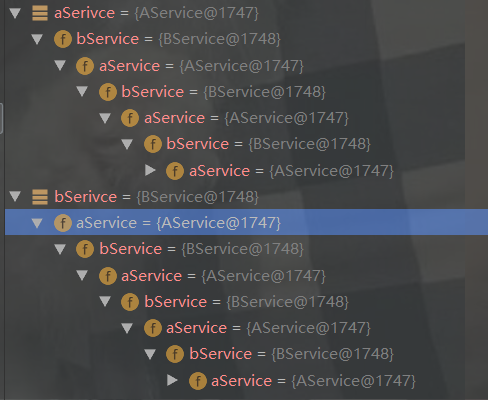
жҖқиҖғй—®йўҳпјҡеҚ•дҫӢеҜ№иұЎеңЁд»Җд№Ҳж—¶еҖҷеҲӣе»әпјҹ
еңЁIOCе®№еҷЁиў«еҲӣе»әзҡ„ж—¶еҖҷеҲӣе»ә
еӨҡдҫӢзҡ„жғ…еҶөдёӢпјҢжҳҜеңЁgetbeanпјҲпјүи°ғз”Ёзҡ„жғ…еҶөдёӢеҲӣе»әгҖӮеӨҡдҫӢеҜ№иұЎжҜҸж¬Ўз”Ёе®Ңе°ұдјҡеҺ»й”ҖжҜҒжҺүгҖӮ
AnnotationConfigApplicationContext applicationContext = new AnnotationConfigApplicationContext(MyConfig.class);

// Instantiate all remaining (non-lazy-init) singletons. finishBeanFactoryInitialization(beanFactory);
// Instantiate all remaining (non-lazy-init) singletons. beanFactory.preInstantiateSingletons();
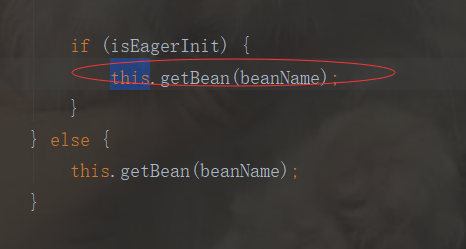
public Object getBean(String name) throws BeansException {
return this.doGetBean(name, (Class)null, (Object[])null, false);
}
public Object getSingleton(String beanName) {
return this.getSingleton(beanName, true);
}иҺ·еҸ–зј“еӯҳеҜ№иұЎпјҡ
protected Object getSingleton(String beanName, boolean allowEarlyReference) {
Object singletonObject = this.singletonObjects.get(beanName); //ж №жҚ®BeanNameеҺ»йӣҶеҗҲдёӯжҹҘпјҢжҹҘеҲ°е°ұиҝ”еӣһиҝҷдёӘеҜ№иұЎпјҢгҖҗгҖ‘гҖҗгҖ‘гҖҗгҖ‘дёҖзә§зј“еӯҳеҜ№иұЎйӣҶеҗҲгҖҗгҖ‘гҖҗгҖ‘гҖҗгҖ‘зј“еӯҳе®Ңж•ҙеҜ№иұЎгҖҗгҖ‘гҖҗгҖ‘е®Ңж•ҙеҜ№иұЎиЎЁзӨәеҜ№иұЎе·Із»ҸеҲӣе»әе®ҢдәҶпјҢ并且еҜ№иұЎеұһжҖ§е·Із»ҸиөӢеҖјдәҶгҖӮ
if (singletonObject == null && this.isSingletonCurrentlyInCreation(beanName)) {
Map var4 = this.singletonObjects;
synchronized(this.singletonObjects) {
singletonObject = this.earlySingletonObjects.get(beanName); //жҹҘиҜўдәҢзә§зј“еӯҳдёӯжҳҜеҗҰжңүзј“еӯҳеҜ№иұЎ
if (singletonObject == null && allowEarlyReference) {
ObjectFactory<?> singletonFactory = (ObjectFactory)this.singletonFactories.get(beanName); //жҹҘиҜўдёүзә§зј“еӯҳпјҢдёүзә§зј“еӯҳдёӯжңүзҡ„еҢ–пјҢе°Ҷдёүзә§зј“еӯҳдёӯзҡ„ж•°жҚ®ж”ҫе…ҘдәҢзә§зј“еӯҳдёӯ
if (singletonFactory != null) {
singletonObject = singletonFactory.getObject();
this.earlySingletonObjects.put(beanName, singletonObject);
this.singletonFactories.remove(beanName);
}
}
}
}
return singletonObject;
}

дёҖзә§зј“еӯҳжІЎжңүжүҫеҲ°пјҢе°ұеҺ»жүҫдәҢзә§зј“еӯҳдёӯжүҫ

singletonObject == null && this.isSingletonCurrentlyInCreation(beanName) //дёҖзә§зј“еӯҳжІЎжңүпјҢ并且singletonsCurrentlyInCreationеҲӨж–ӯжҳҜеҗҰд№ӢеүҚж Үи®°дёәиҜҘеҜ№иұЎејҖе§ӢеҲӣе»ә


if (isPrototypeCurrentlyInCreation(beanName)) { //жҲ‘们еҜ№иұЎжҳҜеҚ•дҫӢзҡ„пјҢжүҖжңүдёҚиҝӣе…Ҙ
throw new BeanCurrentlyInCreationException(beanName);
}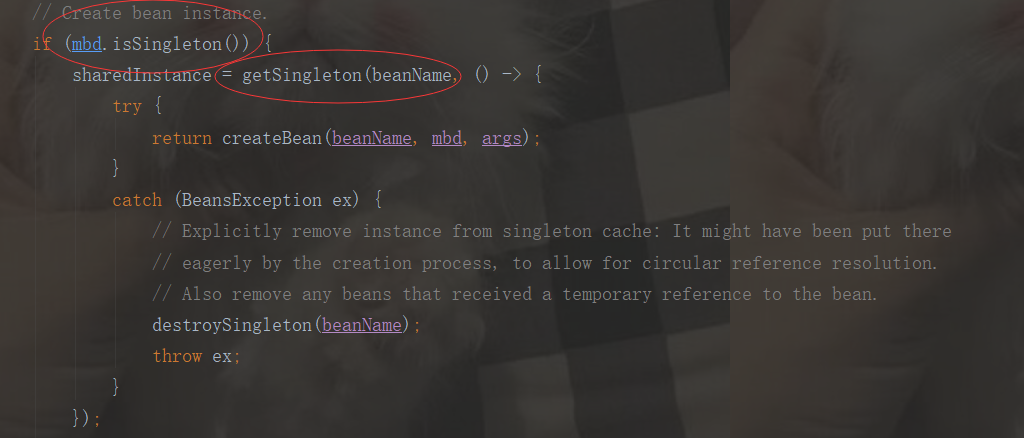
public Object getSingleton(String beanName, ObjectFactory<?> singletonFactory) {
Assert.notNull(beanName, "Bean name must not be null");
synchronized (this.singletonObjects) {
Object singletonObject = this.singletonObjects.get(beanName);
if (singletonObject == null) {
if (this.singletonsCurrentlyInDestruction) {
throw new BeanCreationNotAllowedException(beanName,
"Singleton bean creation not allowed while singletons of this factory are in destruction " +
"(Do not request a bean from a BeanFactory in a destroy method implementation!)");
}
if (logger.isDebugEnabled()) {
logger.debug("Creating shared instance of singleton bean '" + beanName + "'");
}
beforeSingletonCreation(beanName);
boolean newSingleton = false;
boolean recordSuppressedExceptions = (this.suppressedExceptions == null);
if (recordSuppressedExceptions) {
this.suppressedExceptions = new LinkedHashSet<>();
}
try {
singletonObject = singletonFactory.getObject();
newSingleton = true;
}
catch (IllegalStateException ex) {
// Has the singleton object implicitly appeared in the meantime ->
// if yes, proceed with it since the exception indicates that state.
singletonObject = this.singletonObjects.get(beanName);
if (singletonObject == null) {
throw ex;
}
}
catch (BeanCreationException ex) {
if (recordSuppressedExceptions) {
for (Exception suppressedException : this.suppressedExceptions) {
ex.addRelatedCause(suppressedException);
}
}
throw ex;
}
finally {
if (recordSuppressedExceptions) {
this.suppressedExceptions = null;
}
afterSingletonCreation(beanName);
}
if (newSingleton) {
addSingleton(beanName, singletonObject);
}
}
return singletonObject;
}
}
protected void beforeSingletonCreation(String beanName) {
if (!this.inCreationCheckExclusions.contains(beanName) && !this.singletonsCurrentlyInCreation.add(beanName)) {
throw new BeanCurrentlyInCreationException(beanName);
}
}ж ҮиҜҶдёәиҜҘеҜ№иұЎејҖе§ӢеҲӣе»ә

жңҖз»Ҳи°ғз”Ё
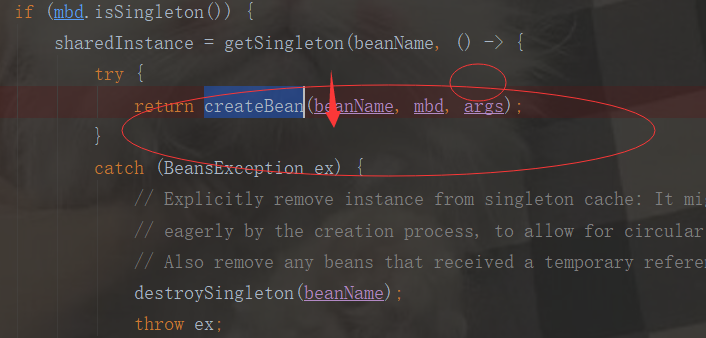
жӯЈзңҹеҺ»еҲӣе»әжҲ‘们зҡ„BeanеҜ№иұЎпјҡ

既然иҰҒеҲӣе»әеҜ№иұЎпјҢе…ҲеҸҚе°„иө°ж— еҸӮжһ„йҖ еҮҪж•°пјҢеҜ№иұЎе…Ҳе®һдҫӢеҢ–е®ҢжҲҗпјҢеңЁиөӢеҖј

жү§иЎҢиҝҷдёӘж–№жі•пјҢиҫ“еҮәжһ„йҖ еҮҪж•°жү“еҚ°зҡ„иҜӯеҸҘпјҢиҜҙжҳҺеә•еұӮйҖҡиҝҮJavaеҸҚе°„жңәеҲ¶еҲқе§ӢеҢ–зҡ„

еңЁиҝҷд№ӢеүҚпјҢжҲ‘们зҡ„еҜ№иұЎеұһдәҺе©ҙе„ҝеҜ№иұЎпјҢеӣ дёәе®ғзҡ„еұһжҖ§иҝҳжІЎжңүиөӢеҖјгҖӮйғҪжҳҜз§°дёәе©ҙе„ҝеҜ№иұЎгҖӮ
йӮЈд№Ҳд»Җд№Ҳж—¶еҖҷиөӢеҖје‘ўпјҹ

populateBean(beanName, mbd, instanceWrapper);//иҝҷйҮҢз»ҷеҜ№иұЎеұһжҖ§иөӢеҖј
еңЁз»ҷеҜ№иұЎеұһжҖ§иөӢеҖјд№ӢеүҚпјҡ
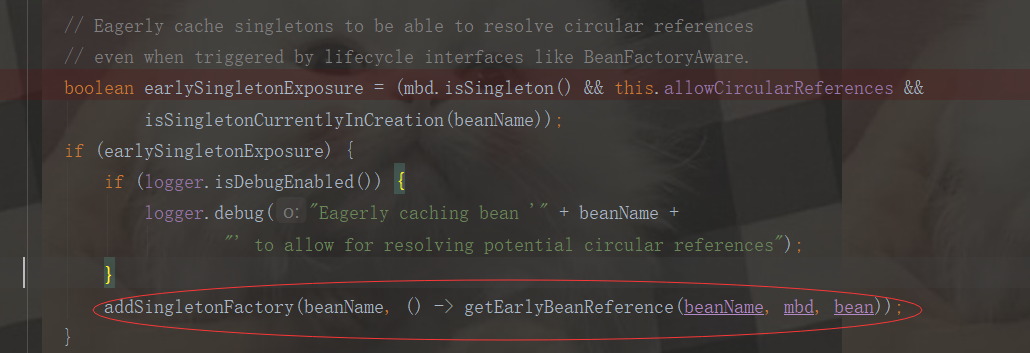
protected void addSingletonFactory(String beanName, ObjectFactory<?> singletonFactory) {
Assert.notNull(singletonFactory, "Singleton factory must not be null");
synchronized (this.singletonObjects) {
if (!this.singletonObjects.containsKey(beanName)) { //гҖҗгҖ‘гҖҗгҖ‘еҰӮжһңдёҖзә§зј“еӯҳжІЎжңүиҜҘеҜ№иұЎзҡ„жғ…еҶөдёӢпјҢдјҡе°ҶиҜҘеҜ№иұЎеӯҳж”ҫеңЁдёүзә§зј“еӯҳдёӯ
this.singletonFactories.put(beanName, singletonFactory); //гҖҗгҖ‘гҖҗгҖ‘еӯҳж”ҫеңЁдёүзә§зј“еӯҳдёӯпјҢеҜ№иұЎе®һдҫӢеҢ–е®ҢжҲҗпјҢдҪҶжҳҜжІЎжңүиөӢеҖјпјҢе©ҙе„ҝеҜ№иұЎгҖҗгҖ‘гҖҗгҖ‘
this.earlySingletonObjects.remove(beanName);
this.registeredSingletons.add(beanName);
}
}
}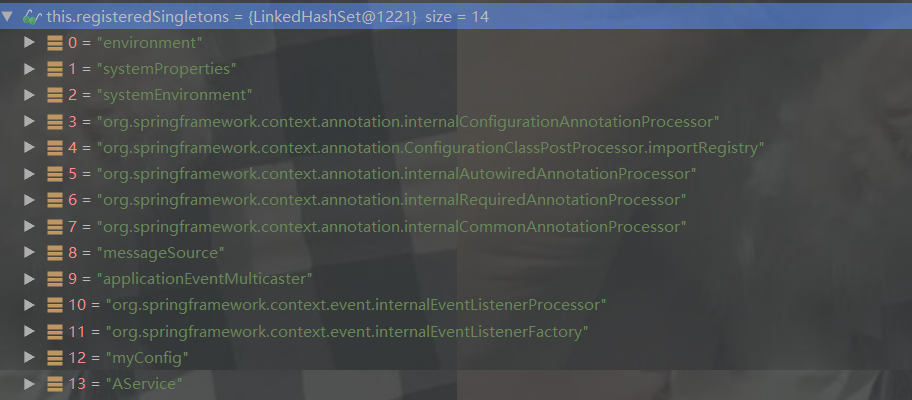

AеҜ№иұЎеқҡжҢҒдҫқиө–BеҜ№иұЎпјҢиҝҷж—¶еҖҷBеҜ№иұЎд№ҹйңҖиҰҒиў«еҲӣе»ә
AеҜ№иұЎе·Із»Ҹеӯҳж”ҫеңЁдёүзә§зј“еӯҳдёӯпјҢиҝҷж—¶еҖҷиҰҒеҺ»еҲӣе»әBеҜ№иұЎ
жӯӨж—¶BеҜ№иұЎд№ҹиҰҒиө°AеҜ№иұЎжөҒзЁӢ

зңӢдёӢи°ғз”Ёй“ҫ
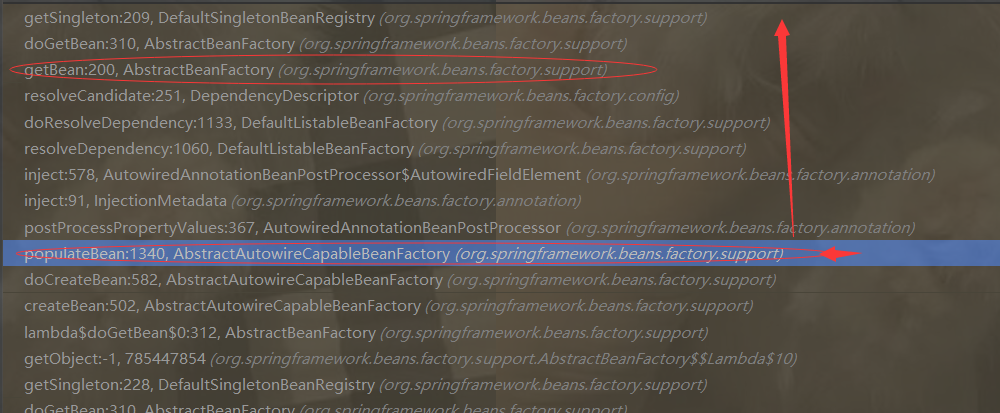


д№ҹе°ҶBеҜ№иұЎж”ҫе…Ҙдёүзә§зј“еӯҳ

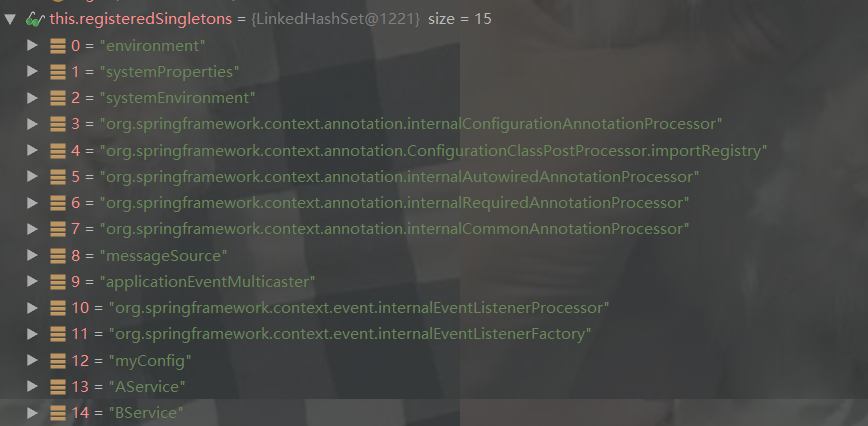
жҖ»з»“дёӢпјҡ
AServiceеңЁеҲӣе»әзҡ„ж—¶еҖҷпјҢжҸҗеүҚжӣқе…үеӯҳж”ҫеҲ°дёүзә§зј“еӯҳдёӯпјҢAServiceеҸ‘зҺ°дҫқиө–BService,иҝҷж—¶еҖҷBserviceжҸҗеүҚжӣқе…үеӯҳж”ҫеҲ°дёүзә§зј“еӯҳдёӯеҺ»гҖӮ
жӯӨж—¶BServiceеҸҲдҫқиө–AServiceпјҢжӯӨж—¶BServiceз»ҸиҝҮиөӢеҖјжҳҜе®Ңж•ҙеҜ№иұЎпјҢдҪҶжҳҜAserviceиҝҳжҳҜе©ҙе„ҝеҜ№иұЎпјҢжІЎжңүе®Ңе…ЁеҲӣе»әе®ҢжҜ•гҖӮ
е°ұдјҡеҺ»жҠҠBServiceеҜ№иұЎжіЁеҶҢеҲ°дёҖзә§зј“еӯҳдёӯпјҢеҗҢж—¶дјҡжҠҠд№ӢеүҚзј“еӯҳBServiceеҜ№иұЎзҡ„дәҢзә§зј“еӯҳжё…йҷӨжҺү
AServiceеҜ№иұЎдҫқиө–BService,BServiceжӯӨж—¶е·Із»ҸеҲӣе»әжҲҗеҠҹдәҶпјҢйӮЈд№ҲAServiceеңЁи®ҫзҪ®еұһжҖ§еҗҺпјҢе°ұзӣҙжҺҘжҠҠBServiceиөӢеҖјз»ҷAServiceгҖӮ
ејҖе§ӢжіЁеҶҢAServiceеҜ№иұЎ


SpringBeanдёӯ AservicеҜ№иұЎиў«еҲӣе»әжөҒзЁӢжӯҘйӘӨжәҗз ҒеҲҶжһҗпјҡ
doGetBeanеҲӣе»әжҲ‘们beanеҜ№иұЎ
getSingleton пјҲbeanNameпјү иҺ·еҸ–зј“еӯҳеҜ№иұЎ
жіЁж„Ҹпјҡе®Ңж•ҙеҜ№иұЎжҰӮеҝөпјҡеҜ№иұЎе·Із»Ҹе®һдҫӢеҢ–жҲҗеҠҹ并且жүҖжңүеұһжҖ§йғҪе·Із»ҸиөӢеҖј
singletonObjects дёҖзә§зј“еӯҳе®Ңж•ҙеҜ№иұЎ
earlySingletonObjects дәҢзә§зј“еӯҳ зј“еӯҳе©ҙе„ҝеҜ№иұЎ
singletonFactories дёүзә§зј“еӯҳеӯҳж”ҫе©ҙе„ҝеҜ№иұЎ
зҗҶи§ЈжҰӮеҝө:
е®Ңж•ҙеҜ№иұЎиЎЁзӨәиҜҘеҜ№иұЎе®һдҫӢеҢ–е®ҢжҲҗ并且жүҖжңүзҡ„еұһжҖ§е·Із»ҸиөӢеҖјгҖӮ
е©ҙе„ҝеҜ№иұЎпјҲжҸҗеүҚеҜ№иұЎпјүеҜ№иұЎе·Із»Ҹе®һдҫӢеҢ–е®ҢжҲҗдҪҶжҳҜеұһжҖ§жІЎжңүиөӢеҖјзҡ„гҖӮ
singletonObject ==null&&this.singletonsCurrentlyInCreation.contains(beanName);
{
жүҚиғҪеӨҹжҹҘиҜўдәҢзә§зј“еӯҳ
}
singletonsCurrentlyInCreation пјҡж Үи®°дёәиҜҘеҜ№иұЎејҖе§ӢеҲӣе»ә
getSingleton(String beanName, ObjectFactory<?> singletonFactory)
this.singletonsCurrentlyInCreation.add(beanName) иЎЁзӨәиҜҘеҜ№иұЎе·Із»ҸејҖе§ӢеҲӣе»ә
createBean() вҶ’doCreateBean
addSingletonFactory е°Ҷе©ҙе„ҝеҜ№иұЎпјҲдёҚе®Ңж•ҙеҜ№иұЎд№ҹе°ұжҳҜеҸӘжҳҜе®һдҫӢеҢ–е®ҢжҲҗдҪҶжҳҜеұһжҖ§жІЎжңүиөӢеҖјзҡ„пјү еӯҳж”ҫдёүзә§зј“еӯҳдёӯгҖӮ
AеҜ№иұЎе·Із»Ҹеӯҳж”ҫеҲ°дёүзә§зј“еӯҳдёӯпјҢејҖе§Ӣз»ҷеҜ№иұЎеұһжҖ§иөӢеҖјзҡ„ж—¶еҖҷ йңҖиҰҒеҲӣе»әBеҜ№иұЎгҖӮ
AеҜ№иұЎжЈҖжҹҘеҸ‘зҺ°дҫқиө–BеҜ№иұЎ иҝҷж—¶еҖҷBеҜ№иұЎд№ҹйңҖиҰҒиў«еҲӣе»ә
д»ҘдёҠе°ұжҳҜSpringBeanеҫӘзҺҜдҫқиө–й—®йўҳзҡ„и§ЈеҶіж–№жі•пјҢе°Ҹзј–зӣёдҝЎжңүйғЁеҲҶзҹҘиҜҶзӮ№еҸҜиғҪжҳҜжҲ‘们ж—Ҙеёёе·ҘдҪңдјҡи§ҒеҲ°жҲ–з”ЁеҲ°зҡ„гҖӮеёҢжңӣдҪ иғҪйҖҡиҝҮиҝҷзҜҮж–Үз« еӯҰеҲ°жӣҙеӨҡзҹҘиҜҶгҖӮжӣҙеӨҡиҜҰжғ…敬иҜ·е…іжіЁдәҝйҖҹдә‘иЎҢдёҡиө„и®Ҝйў‘йҒ“гҖӮ
е…ҚиҙЈеЈ°жҳҺпјҡжң¬з«ҷеҸ‘еёғзҡ„еҶ…е®№пјҲеӣҫзүҮгҖҒи§Ҷйў‘е’Ңж–Үеӯ—пјүд»ҘеҺҹеҲӣгҖҒиҪ¬иҪҪе’ҢеҲҶдә«дёәдё»пјҢж–Үз« и§ӮзӮ№дёҚд»ЈиЎЁжң¬зҪ‘з«ҷз«ӢеңәпјҢеҰӮжһңж¶үеҸҠдҫөжқғиҜ·иҒ”зі»з«ҷй•ҝйӮ®з®ұпјҡis@yisu.comиҝӣиЎҢдёҫжҠҘпјҢ并жҸҗдҫӣзӣёе…іиҜҒжҚ®пјҢдёҖз»ҸжҹҘе®һпјҢе°Ҷз«ӢеҲ»еҲ йҷӨж¶үе«ҢдҫөжқғеҶ…е®№гҖӮ